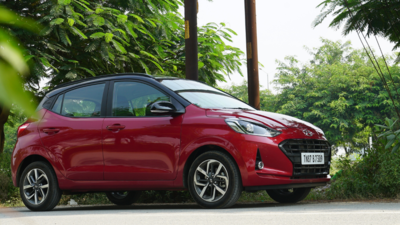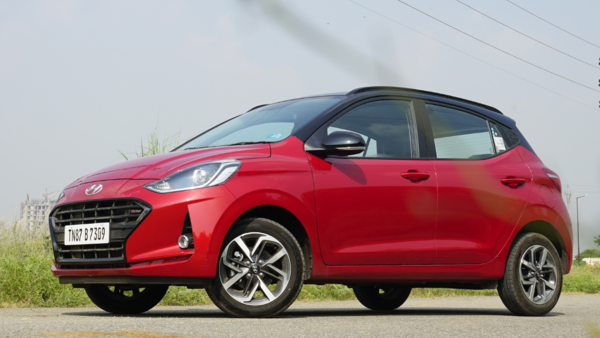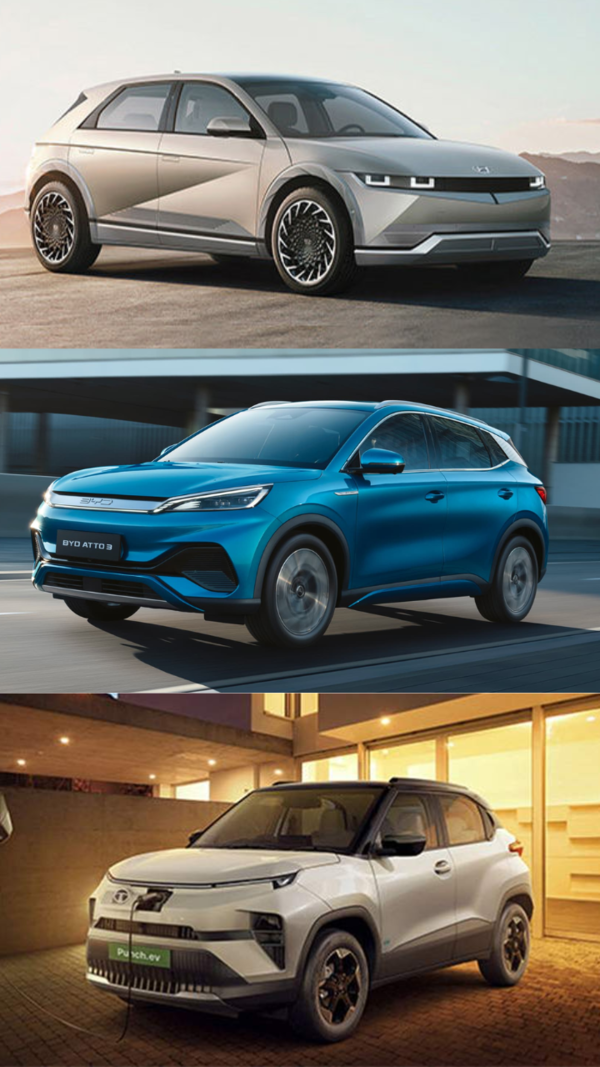Trending
This story is from September 21, 2020
Hyundai Grand i10 Nios turbo review: Hot hatchback with limitations
A three-cylinder petrol engine, 100PS and 172 Nm of output with a 5-speed manual. This combination is extremely lucrative and is the same as the Hyundai Aura. The turbo variant is priced somewhere around Rs 7.70 lakh (ex-showroom), and is expensive over the regular petrol variant by almost Rs 1 - 1.25 lakh (ex-showroom).

NEW DELHI: If cars like Volkswagen Polo, Maruti Suzuki Baleno RS and other hot hatchbacks made sense to you, this will surely excite you. Meet the all-new turbo variant of Grand i10 Nios.
Now, neither Grand i10 Nios is new nor is the Hyundai’s turbo engine. This is the same engine as in the Aura and the Nios turbo was put on display at the Auto Expo. Today’s story is about a small car that is capable of pinning down big ones in a drag race.
A three-cylinder petrol engine, 100PS and 172 Nm of output with a 5-speed manual.This combination is extremely lucrative and is the same as the Hyundai Aura. No automatic or DCT yet. Time to have some fun.
The clutch is light and though the gear shifts are not butter smooth, meanwhile, the throws are short and precise. Thanks to a meaty mid-range, the Nios doesn’t require often gear shifts in start-stop traffic. And on the highways, overtaking is more natural now.

i10, as a brand, has evolved over the years, matured itself to meet customer expectations. The ride is nicely tuned, takes most undulations comfortably at low speeds. However, if you come across unevenness at greater speeds, the ride, especially, for the rear seats could get disturbing.

The platform, chassis and steering geometry of Aura and Grand i10 Nios are the same. That said, I wasn’t particularly confident around the corners holding good speeds. Similarly, the dynamic engine is eager to rush so much so that Nios Turbo could clock 150 kmph on the speedo without breaking a sweat. On the flip side, at high speeds, the Nios feels floaty on the tarmac and doesn’t feel all that grounded.

For a fact, Hyundai’s turbo-chargers are efficient. The turbo Nios pulls off almost the same mileage as the manual. The third-generation Grand i10, better known as the Nios, was introduced last year.
The turbo variant is priced somewhere around Rs 7.70 lakh (ex-showroom), and is expensive over the regular petrol variant by almost Rs 1 - 1.25 lakh (ex-showroom). What else than a powerful engine do you get?

As for the looks, Grand i10 Nios is a delightful car to take around. The dimensions are compact, the layout is interesting and isn’t as boring as a few of its rivals. For the turbo variant, in particular, the blacked-out grille is complemented by a red badge. You get Boomerang-shaped LED day time running lights, swept-back headlights and circular fog lamp housing and I hope you liked with dual-tone colour. Because we absolutely loved it.
The machine cut design of the alloys are intriguing and is in line with the Aura. The NIOS badging in bold chrome blocks is a bit different now, reflecting the Turbo trim.
On the inside, you get quite a long list of creature comforts, especially for the price segment Nios settles in. An 8-inch infotainment system with Android Auto, Apple CarPlay, wireless charging, multiple USB ports, a digital display in front of the driver, AC vents for the second-row occupants, rear parking camera and eco coating in air conditioning to filter out bad odour. Much like the Hyundai’s turbo hierarchy, the Nios also gets all-black upholstery with red stitching. Honestly, it’s better specced than most of its rivals in the segment.
Hyundai claims complete credit for democratizing small-sized, turbocharged engines. From i10 Nios to Verna and Creta, the entire range gets a turbo boost. That said, I’m not a big fan of a turbo engine in a car that weighs just 900 kilos and comes with dual airbags, and without ESP or drive modes.
The engine is juicy and responsive, the conveniences are comforting and the Grand i10 Nios is one of the good looking hatchbacks out there. We appreciate Hyundai for delivering us the most-affordable turbo. But the question for you to decide is whether you would like to spend that much amount on a small hatchback or not.
Now, neither Grand i10 Nios is new nor is the Hyundai’s turbo engine. This is the same engine as in the Aura and the Nios turbo was put on display at the Auto Expo. Today’s story is about a small car that is capable of pinning down big ones in a drag race.
A three-cylinder petrol engine, 100PS and 172 Nm of output with a 5-speed manual.This combination is extremely lucrative and is the same as the Hyundai Aura. No automatic or DCT yet. Time to have some fun.
Hyundai Grand i10 Nios Turbo | Hot hatchback with limitations | Review
Yes, 100 and not 120 like the Venue or Creta. And a 5-speed manual instead of 6. Being petrol and turbocharged, the calmness and refinement of the engine go well with the Nios. Due to the turbo lag, the initial response at low revs isn’t all that great. Put the foot on the pedal, and the Nios is ready to sprint. The rev needle pulls clean with a strong surge through the mid-range, all the way until 6,500 rpm. It’s only past 4,000-rpm-mark that you tend to hear engine grumble. Interestingly, Nios is also the lightest car with a turbocharger. So, on the driver’s seat, if you lose your attention for a moment, even a slight torque steer could be frightening.
The clutch is light and though the gear shifts are not butter smooth, meanwhile, the throws are short and precise. Thanks to a meaty mid-range, the Nios doesn’t require often gear shifts in start-stop traffic. And on the highways, overtaking is more natural now.

i10, as a brand, has evolved over the years, matured itself to meet customer expectations. The ride is nicely tuned, takes most undulations comfortably at low speeds. However, if you come across unevenness at greater speeds, the ride, especially, for the rear seats could get disturbing.

The platform, chassis and steering geometry of Aura and Grand i10 Nios are the same. That said, I wasn’t particularly confident around the corners holding good speeds. Similarly, the dynamic engine is eager to rush so much so that Nios Turbo could clock 150 kmph on the speedo without breaking a sweat. On the flip side, at high speeds, the Nios feels floaty on the tarmac and doesn’t feel all that grounded.

For a fact, Hyundai’s turbo-chargers are efficient. The turbo Nios pulls off almost the same mileage as the manual. The third-generation Grand i10, better known as the Nios, was introduced last year.
The turbo variant is priced somewhere around Rs 7.70 lakh (ex-showroom), and is expensive over the regular petrol variant by almost Rs 1 - 1.25 lakh (ex-showroom). What else than a powerful engine do you get?

As for the looks, Grand i10 Nios is a delightful car to take around. The dimensions are compact, the layout is interesting and isn’t as boring as a few of its rivals. For the turbo variant, in particular, the blacked-out grille is complemented by a red badge. You get Boomerang-shaped LED day time running lights, swept-back headlights and circular fog lamp housing and I hope you liked with dual-tone colour. Because we absolutely loved it.
The machine cut design of the alloys are intriguing and is in line with the Aura. The NIOS badging in bold chrome blocks is a bit different now, reflecting the Turbo trim.
On the inside, you get quite a long list of creature comforts, especially for the price segment Nios settles in. An 8-inch infotainment system with Android Auto, Apple CarPlay, wireless charging, multiple USB ports, a digital display in front of the driver, AC vents for the second-row occupants, rear parking camera and eco coating in air conditioning to filter out bad odour. Much like the Hyundai’s turbo hierarchy, the Nios also gets all-black upholstery with red stitching. Honestly, it’s better specced than most of its rivals in the segment.
Hyundai claims complete credit for democratizing small-sized, turbocharged engines. From i10 Nios to Verna and Creta, the entire range gets a turbo boost. That said, I’m not a big fan of a turbo engine in a car that weighs just 900 kilos and comes with dual airbags, and without ESP or drive modes.
The engine is juicy and responsive, the conveniences are comforting and the Grand i10 Nios is one of the good looking hatchbacks out there. We appreciate Hyundai for delivering us the most-affordable turbo. But the question for you to decide is whether you would like to spend that much amount on a small hatchback or not.
End of Article
FOLLOW US ON SOCIAL MEDIA









